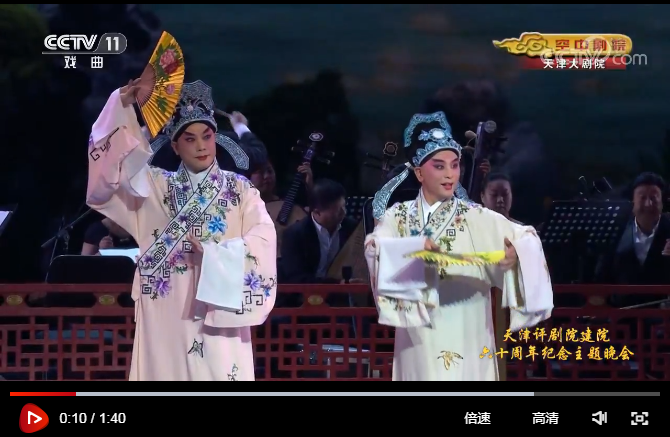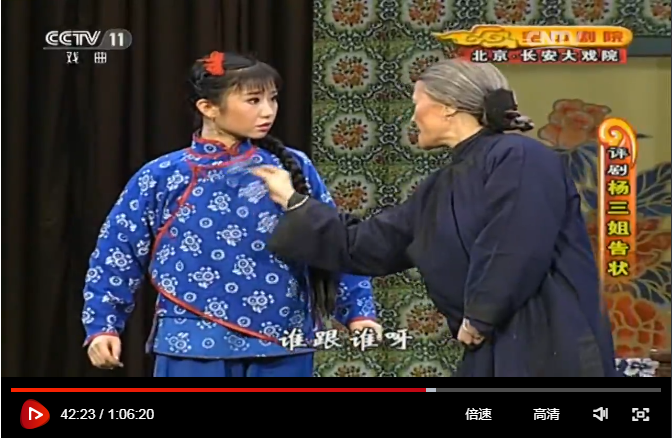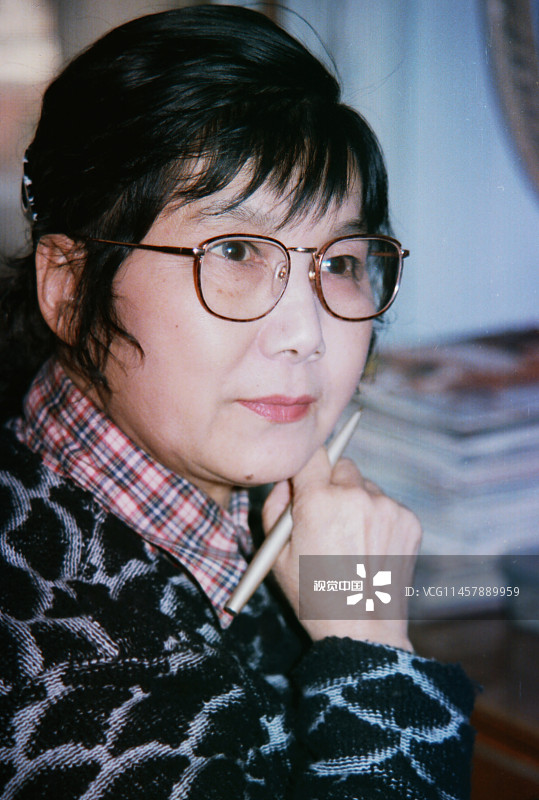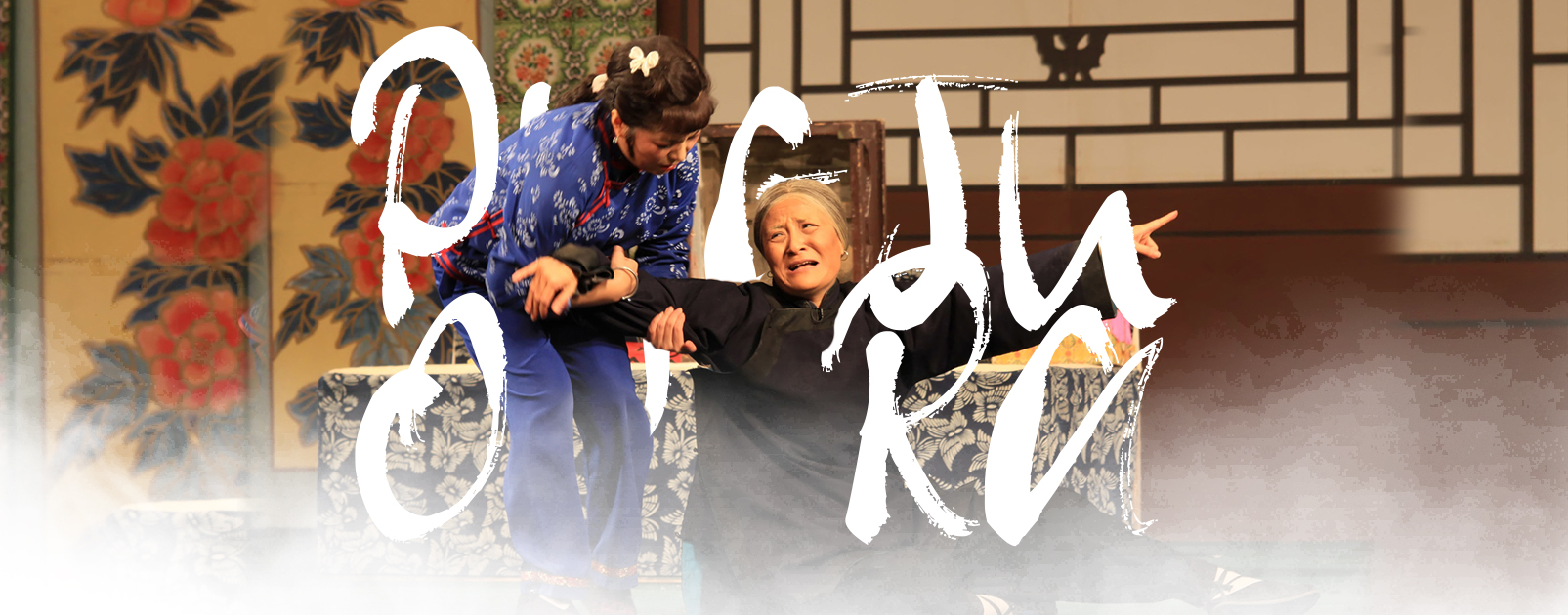
Origin
Pingju opera evolved from Lianhualao, a folk ditty popular in Northern China’s Hebei province and its neighboring area at the end of the Qing Dynasty (1644-1911). It drew inspirations from the Hebei clapper opera (Hebei bangzi) and Peking opera while integrating other vernacular performing arts in northeastern China. By the early 20th century, it had grown into an independent operatic form.
Since the foundation of the People's Republic of China in 1949, Pingju opera has tremendously expanded. A large number of modern stories or plays based on historical events were created which helped promote it.
Roles

In the early stage, Pingju opera didn't have a clear division of roles. In a Pingju drama there were only male and female characters, which were played by two or at most three actors and actresses, portraying different characters with simple stage properties. After a significant reform from 1909 to 1921, Pingju opera grew into a major operatic form. It learnt from the Peking opera and the Hebei clapper opera, and gradually completed its own category of roles. Now the Pingju opera has female role types (Dan) of the Qingyi (mature, virtuous, and elite women), Huadan (unmarried women), Laodan (old women), and Caidan (amusing women), male role types (Sheng) of Xiaosheng (young men) and Laosheng (old men), rough man role of Hualian (Jing, the painted-face male role with a forceful character), and the clown role (Chou). After the New China was founded, the male roles of Pingju opera substantially developed -- the Huanglian role was created and the Laosheng role was perfected. Pingju opera’s musical accompaniment was also reformed to adapt to new vocal categories.

Themes of the Pingju Repertoire

An influential regional theatre, most Pingju operas tell stories of the virtuous and the righteous triumphing over evil. To some extent, this new form of operatic art was created to remark on both the past and the contemporary, accounting for its name -- in the Chinese language Pingju could be translated as "plays of remark". The librettist Cheng Zhaocai (1874-1929), regarded as the founding father of Pingju opera, was quick to respond to the changes of the time. He wrote a number of well received modern plays which reflect contemporary life. One work in his repertoire, Third Sister Yang Files a Lawsuit (Yangsanjie gaozhuang), has enjoyed great popularity since its debut in 1919, and has become a Pingju opera classic.
Musical Instruments
Accompanying musical instruments consist of two groups: String and wind instrument and percussion instruments. The percussion instruments include drum, Bangzi (watchman’s clapper), gong, and small cymbals, while string and wind instruments include Banhu, Erhu, Zhonghu, Dihu (a bowed two stringed instrument with a thin wooden soundboard), and Pipa lute. Western musical instruments including bass, brass-wind instruments, cello, and violin, have also been adopted.

Tunes
The tunes of Pingju opera are developed on the basis of the folk music of Tangshan folk songs and Lianhualuo, absorbing musical factors of other local operas such as the northeast song-and-dance duet, Peking opera, Hebei clapper opera and other local operas in Beijing and Tianjin.
Founding Artists
Cheng Zhaocai (1874-1929)
Born into a poor peasant family in Hebei province, Cheng started his career as a local Lianhualao performer. He made remarkable contributions to the formation and evolution of Pingju opera. He collated, adapted, and created more than a hundred librettos of Pingju opera, laying the foundation for the establishment of this very operatic art. He has been lauded as the King of Pingju opera libretto.
Li Zaiwen (Stage name Xiao Bai Yushuang, 1922-1967)
She is the founder of the New Bai School of Pingju opera and was a bellwether of Pingju opera in the 1950s and 1960s. She began to perform on stage at the age of 14 and rose to fame in Beijing and Tianjin. Her voice was rounded and melodious. She paid a lot of attention to variations of rhythm and voice, which contributed to natural and expressive vocal performances. She interpreted many traditional Chinese female characters of Pingju opera, often heroines, including Zhao Jintang in Story of a Red Mole (Zhuhen ji), and and title characters in The Courtesan Du Shiniang (Du Shiniang) and Madam Qin Xianglian (Qin Xianglian). Her representative work Madam Qin Xianglian absorbed the quintessence of other traditional Chinese operas and enriched the charisma of her performances.
Yang Shumin (Stage name Xin Fengxia, 1927-1998)

Founder of the Xin School of Pingju opera. She learnt the art from 13 years old, and played leading roles in a group of Pingju operas at 15. After the founding of the People's Republic of China in 1949, she gained popularity among the public and became a household name by playing the heroine of the Pingju opera Liu Qiao'er, a classic play of the Pingju repertoire. Collaborating with operatic musicians, she has created a number of new tunes to enrich the opera’s vocal diversity. Take, for example, arias in the Qiankun Belt (Qiankun dai), Legend of Wushuang (Wushuang zhuan), Legend of Chunxiang (Chunxiang zhuan), Along the Jinsha River Bank (Jinsha jiangpan), and Three Peeks at the Imperial Sister (Sankan yumei). She stood out among Pingju opera actresses and developed a school of her own. She is a pioneer of Pingju opera reform.
Zhang Defu (1931- )
The founder of the Zhang School of the young male role (Xiaosheng), he started as a child apprentice in a Pingju opera troupe based in Beijing, and debuted on the Pingju stage at the age of 13. In 1953, he joined the China Pingju Theatre and his career then underwent fast development. His representative works include Liu Qiao'er, Wife of Xianglin (Xianglin sao) and Flower is a Go-Between.
